Number 717 - Louis Armstrong
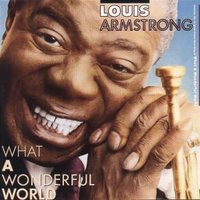
Number 717
Louis Armstrong
"Wonderful World"
(1968)
.
.
Louis Armstrong
"Wonderful World"
(1968)
.
.
This song by Louis Armstrong use to drive me nuts, so syrupy and wishy washy feely good song Aaarrrggghhhhhhhhh! But now as i'm older i have grown a tolerance to the song. Yes i know it's a classic hence why it is here in "The Definitive 1000 Songs Of All Time" and also because of the importance he had in the history of Rock. (now shhhh i need some Floyd to calm me nerves)
Louis Armstrong was the first important soloist to emerge in jazz, and he became the most influential musician in the music's history. As a trumpet virtuoso, his playing, beginning with the 1920s studio recordings made with his Hot Five and Hot Seven ensembles, charted a future for jazz in highly imaginative, emotionally charged improvisation. For this, he is revered by jazz fans. But Armstrong also became an enduring figure in popular music, due to his distinctively phrased bass singing and engaging personality, which were on display in a series of vocal recordings and film roles. Armstrong had a difficult childhood. William Armstrong, his father, was a factory worker who abandoned the family soon after the boy's birth. Armstrong was brought up by his mother, Mary (Albert) Armstrong, and his maternal grandmother. He showed an early interest in music, and a junk dealer for whom he worked as a grade-school student helped him buy a cornet, which he taught himself to play. He dropped out of school at 11 to join an informal group, but on December 31, 1912, he fired a gun during a New Year's Eve celebration, for which he was sent to reform school. He studied music there and played cornet and bugle in the school band, eventually becoming its leader. He was released on June 16, 1914, and did manual labor while trying to establish himself as a musician. He was taken under the wing of cornetist Joe "King" Oliver, and when Oliver moved to Chicago in June 1918, he replaced him in the Kid Ory Band. He moved to the Fate Marable band in the spring of 1919, staying with Marable until the fall of 1921.
 He also took a series of small parts in motion pictures, beginning with Pennies From Heaven in December 1936, and he continued to record for Decca, resulting in the Top Ten hits "Public Melody Number One" (August 1937), "When the Saints Go Marching in" (April 1939), and "You Won't Be Satisfied (Until You Break My Heart)" (April 1946), the last a duet with Ella Fitzgerald. He returned to Broadway in the short-lived musical +Swingin' the Dream in November 1939.
He also took a series of small parts in motion pictures, beginning with Pennies From Heaven in December 1936, and he continued to record for Decca, resulting in the Top Ten hits "Public Melody Number One" (August 1937), "When the Saints Go Marching in" (April 1939), and "You Won't Be Satisfied (Until You Break My Heart)" (April 1946), the last a duet with Ella Fitzgerald. He returned to Broadway in the short-lived musical +Swingin' the Dream in November 1939.  With the decline of swing music in the post-World War II years, Armstrong broke up his big band and put together a small group dubbed the All Stars, which made its debut in Los Angeles on August 13, 1947. He embarked on his first European tour since 1935 in February 1948, and thereafter toured regularly around the world. In June 1951 he reached the Top Ten of the LP charts with Satchmo at Symphony Hall ("Satchmo" being his nickname), and he scored his first Top Ten single in five years with "(When We Are Dancing) I Get Ideas" later in the year. The single's B-side, and also a chart entry, was "A Kiss to Build a Dream On," sung by Armstrong in the film The Strip. In 1993, it gained renewed popularity when it was used in the film Sleepless in Seattle. Armstrong completed his contract with Decca in 1954, after which his manager made the unusual decision not to sign him to another exclusive contract but instead to have him freelance for different labels.
With the decline of swing music in the post-World War II years, Armstrong broke up his big band and put together a small group dubbed the All Stars, which made its debut in Los Angeles on August 13, 1947. He embarked on his first European tour since 1935 in February 1948, and thereafter toured regularly around the world. In June 1951 he reached the Top Ten of the LP charts with Satchmo at Symphony Hall ("Satchmo" being his nickname), and he scored his first Top Ten single in five years with "(When We Are Dancing) I Get Ideas" later in the year. The single's B-side, and also a chart entry, was "A Kiss to Build a Dream On," sung by Armstrong in the film The Strip. In 1993, it gained renewed popularity when it was used in the film Sleepless in Seattle. Armstrong completed his contract with Decca in 1954, after which his manager made the unusual decision not to sign him to another exclusive contract but instead to have him freelance for different labels.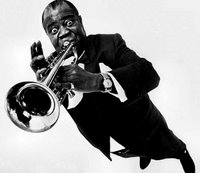 Satch Plays Fats, a tribute to Fats Waller, became a Top Ten LP for Columbia in October 1955, and Verve Records contracted Armstrong for a series of recordings with Ella Fitzgerald, beginning with the chart LP Ella and Louis in 1956. Armstrong continued to tour extensively, despite a heart attack in June 1959. In 1964, he scored a surprise hit with his recording of the title song from the Broadway musical +Hello, Dolly!, which reached number one in May, followed by a gold-selling album of the same name. It won him a Grammy for best vocal performance. This pop success was repeated internationally four years later with "What a Wonderful World," which hit number one in the U.K. in April 1968. It did not gain as much notice in the U.S. until 1987 when it was used in the film Good Morning, Vietnam, after which it became a Top 40 hit.
Satch Plays Fats, a tribute to Fats Waller, became a Top Ten LP for Columbia in October 1955, and Verve Records contracted Armstrong for a series of recordings with Ella Fitzgerald, beginning with the chart LP Ella and Louis in 1956. Armstrong continued to tour extensively, despite a heart attack in June 1959. In 1964, he scored a surprise hit with his recording of the title song from the Broadway musical +Hello, Dolly!, which reached number one in May, followed by a gold-selling album of the same name. It won him a Grammy for best vocal performance. This pop success was repeated internationally four years later with "What a Wonderful World," which hit number one in the U.K. in April 1968. It did not gain as much notice in the U.S. until 1987 when it was used in the film Good Morning, Vietnam, after which it became a Top 40 hit.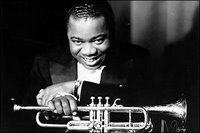 Armstrong was featured in the 1969 film of Hello, Dolly!, performing the title song as a duet with Barbra Streisand. He performed less frequently in the late '60s and early '70s and died of a heart ailment at 69. Louis Armstrong was embraced by two distinctly different audiences: jazz fans who revered him for his early innovations as an instrumentalist, but were occasionally embarrassed by his lack of interest in later developments in jazz and, especially, by his willingness to serve as a light entertainer; and pop fans, who delighted in his joyous performances, particularly as a vocalist, but were largely unaware of his significance as a jazz musician. Given his popularity, his long career, and the extensive label-jumping he did in his later years, as well as the differing jazz and pop sides of his work, his recordings are extensive and diverse, with parts of his catalog owned by many different companies. But many of his recorded performances are masterpieces, and none are less than entertaining. ~ [William Ruhlmann]
Armstrong was featured in the 1969 film of Hello, Dolly!, performing the title song as a duet with Barbra Streisand. He performed less frequently in the late '60s and early '70s and died of a heart ailment at 69. Louis Armstrong was embraced by two distinctly different audiences: jazz fans who revered him for his early innovations as an instrumentalist, but were occasionally embarrassed by his lack of interest in later developments in jazz and, especially, by his willingness to serve as a light entertainer; and pop fans, who delighted in his joyous performances, particularly as a vocalist, but were largely unaware of his significance as a jazz musician. Given his popularity, his long career, and the extensive label-jumping he did in his later years, as well as the differing jazz and pop sides of his work, his recordings are extensive and diverse, with parts of his catalog owned by many different companies. But many of his recorded performances are masterpieces, and none are less than entertaining. ~ [William Ruhlmann]For Barbra Streisand see Number 836
 What did Rolling Stone think about Louis Armstrong
What did Rolling Stone think about Louis Armstrong
To most, Louis Armstrong is just another iconographic Mount Rushmore figure from the distant past -- a patriarch of jazz, a great American cultural ambassador, blah blah blah. Some remember him as that hammy, happily growling presence singing "Hello, Dolly!" Or the cartoonish quipster mugging wide-eyed in some bad movie. But decades before he became a popular entertainer, he'd already made a major contribution as the first true jazz soloist -- an adventurous soul whose musical inquisitiveness and enormous technical skills single-handedly formed the template upon which all small-group jazz improvisation would be built. The recordings on this four-disc collection -- which is far more exhaustively researched than previous reissues of this material -- document the crucial early steps of Armstrong's journey ~[Source: Rolling Stone]
 What did Rolling Stone think about Louis Armstrong
What did Rolling Stone think about Louis ArmstrongTo most, Louis Armstrong is just another iconographic Mount Rushmore figure from the distant past -- a patriarch of jazz, a great American cultural ambassador, blah blah blah. Some remember him as that hammy, happily growling presence singing "Hello, Dolly!" Or the cartoonish quipster mugging wide-eyed in some bad movie. But decades before he became a popular entertainer, he'd already made a major contribution as the first true jazz soloist -- an adventurous soul whose musical inquisitiveness and enormous technical skills single-handedly formed the template upon which all small-group jazz improvisation would be built. The recordings on this four-disc collection -- which is far more exhaustively researched than previous reissues of this material -- document the crucial early steps of Armstrong's journey ~[Source: Rolling Stone]
A huh? Right. Blah blah?
Rolling Stone Top 500 Songs ranked this song at Number (We couldnt hear one Kashmir in his songs) and the Album ranked at Number (What type of guitar did he play?)
This song has a crowbarred rating of 67.7 out of 108 pts
Tags: Louis Armstrong, Jazz, 1968, Ella Fitzgerald, Fats Waller, Barbra Streisand, Music, Youtube, Video, Music Video, Rolling Stone Magazine, The Definitive 1000 Songs of all Time
Search by Genre: ALT POP-ALT PUNK-ALT ROCK-ALTERNATIVE-BIZARRE-BLUES-BRIT POP-COMEDY-COUNTRY-CROONER-DANCE-DISCO-DO WOP-ELECTRONIA-FOLK SINGER-FOLK ROCK-FUNK-GARAGE ROCK-GLAM ROCK-GOSPEL-GRUNGE-GUITARIST-HAIR ROCK-HARD ROCK-HIP HOP-INDIE POP-INDIE ROCK-INDUSTRIAL ROCK- INSTRUMENTAL-JAZZ-LAZY SUNDAY-NEW WAVE-NU ROCK-POP-POP ROCK-PROG ROCK-PSYCHEDELIC ROCK-PUNK POP-PUNK ROCK-R&B-RAP-REGGAE-ROCK-ROCK N ROLL-SINGER SONGWRITER-SKA ROCK-SKIFFLE-SOFT ROCK-SOUL-SOUTHERN ROCK-SURF ROCK-SYNTH POP-TENOR-VOCAL
By The Year 1955 to 2005:
1955, 1956, 1957, 1958, 1959, 1960, 1961, 1962, 1963, 1964, 1965, 1966, 1967, 1968, 1969, 1970, 1971, 1972, 1973, 1974, 1975, 1976, 1977, 1978, 1979, 1980, 1981, 1982, 1983, 1984, 1985, 1986, 1987, 1988, 1989, 1990, 1991, 1992, 1993, 1994, 1995, 1996, 1997, 1998, 1999, 2000, 2001, 2002, 2003, 2004, 2005

underlay trademe
Labels: Louis Armstrong




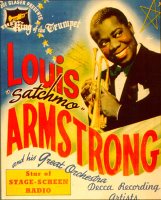





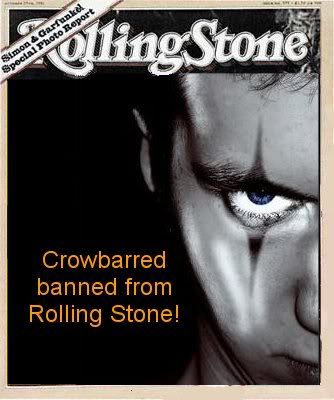








0 Comments:
Post a Comment
<< Home